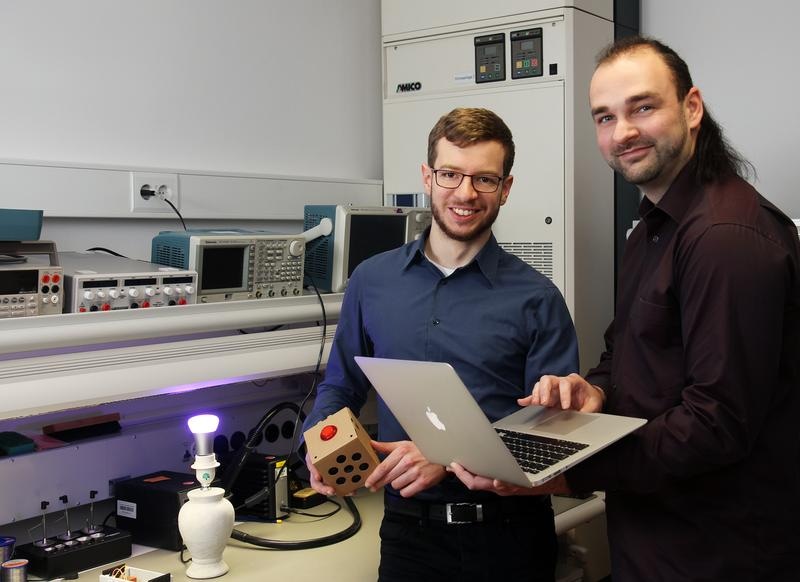Apr 11 2018
Cars, refrigerators, or dishwashers – more and more devices that are utilized on an everyday basis, are being connected over the Internet-of-Things (IoT) and thus can exchange data. Computer scientists at the Technische Universität Kaiserslautern (TUK) are exploring ways to make it simpler to connect devices produced by various manufacturers.
The system is engineered so that the user retains control of who can regulate and use the devices. This requires the use of a microcomputer that links devices in a manner similar to an adapter. The researchers will showcase their system at the Hannover Messe from 23 to 27 April at the Rhineland-Palatine State research booth (Hall 2, Booth B40).
 Johannes Kölsch (left) and Christopher Heinz are working on making it simpler to connect devices made by different manufacturers. (Image credit: TUK/Thomas Koziel)
Johannes Kölsch (left) and Christopher Heinz are working on making it simpler to connect devices made by different manufacturers. (Image credit: TUK/Thomas Koziel)
The IoT is increasing exponentially: for instance, a presentation by the American design company "Infografic Design Team" forecasts that spending for this technology in the medical industry will grow by 15% to touch 117 billion dollars by the year 2020. The increase is anticipated to be fivefold to 25 billion dollars for networked mobile devices.
Also at TUK, researchers Christopher Heinz and Johannes Kölsch are also involved in this technology at the Chair for "Design of Cyber-Physical Systems" with Professor Dr. Christoph Grimm. The specifics: along with colleagues from across Europe, these researchers are designing a software system that links devices and machines produced by various manufacturers. Experts also term this as interoperability. "This term denotes the ability for technical systems produced by different manufacturers to communicate with each other and recognize different signals", explains Ph.D. student Heinz.
The technology functions similar to an adapter that people use to link a power plug from abroad into a socket with a different shape. Researchers utilize a commercially-available microcomputer that comes in a plain cardboard box.
This is what is known as a Voice Kit. It consists of a single-board computer and artificial intelligence that is fitted with voice control as well as other sensors that can measure and detect light intensity and temperature.
Johannes Kölsch
Via a wireless network connection called "ZigBee" that works in the same manner as the more common WiFi, the microcomputer is linked to a device, for instance, a coffee machine or lamp. The miniature computer itself is connected to an online storage or cloud. All crucial data and working of the device are stored in this repository. "We are also connected with our project partners, whose devices can also be controlled from the cloud using similar technology", explains Heinz. It is thus possible to use voice commands and have research colleagues in Greece switch on and off the lights on the Kaiserslautern campus.
With this system, the user maintains control over who can regulate and use the devices. "The user decides who has access. Data transfer between sender and recipient takes place in encrypted form according to the latest security standards", says Kölsch.
The technology is not only for private homes. It can also make it easier for energy suppliers to regulate electricity distribution, for instance. "This may be important in the early evening when energy demands suddenly rise and the grid are overburdened", explains Kölsch. A standard unit can manage the demand and lower it in some areas on demand. Power grid operators have similar agreements already in sync with supermarkets, for instance. They receive low-priced electricity if they are prepared to dim the lights by 10% during periods of high demand on the grid.
Further, companies can connect the equipment in their factories, transport services can network display boards at stops with trains and buses, or hospitals can connect important medical equipment. Another application is in the supply of larger building complexes, which could thus regulate air conditioning, heating, ventilation, and lights more easily.
The research is taking place as a part of the "VICINITY" project, which received 7.5 million euros in financial aid from the European Union. The project is coordinated by Professor Grimm in Kaiserslautern and there are 16 partners from all over Europe. The researchers will introduce the project at the Hannover Messe.